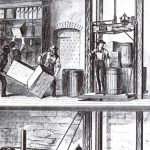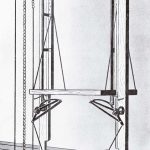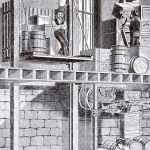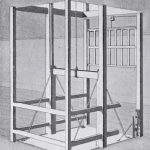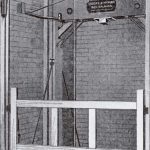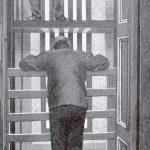The second of two articles examining elevator safety in the U.S. from 1870 to 1920
While the first article in this series (ELEVATOR WORLD, February 2019) focused on reporting and statistics, this article addresses the primary causes of accidents during this period. In addition to gathering accident statistics, several state and municipal agencies referenced in last month’s article also provided information on causes. An examination of the annual reports of the Office of Factory Inspectors for the State of New York from 1888 to 1893, the annual reports of the Chief of the Massachusetts District Police from 1886 to 1913 and a report prepared by the Public Safety Commission of Chicago and Cook County covering the years 1905 to 1916 yielded more than 1,000 accident descriptions. Most of the accidents occurred in factories, warehouses and other industrial buildings. Nonindustrial accident sites included hotels, department stores and office buildings. It is not surprising that most accidents occurred in industrial settings. Even in the 21st century, these settings remain more dangerous than nonindustrial workplaces, and the disparity between these two environments was significantly higher in the 19th and early 20th centuries. This was particularly true regarding elevator safety. However, the vertical- transportation industry’s well-known focus on passenger and operational safety, coupled with the steady development of new safety devices and other technological improvements, prompts the question, “Why were freight elevators more dangerous than passenger elevators?” The answer is simple. The invention of the passenger elevator was predicated on the transformation of the open-platform freight elevator into a system specifically designed to carry passengers. This transformation required the development of an enclosed car with doors and the presence of an operator (who played a critical role in ensuring passenger safety). The development of the passenger elevator was also marked by a continual refinement of these essential components and the invention of new safety devices, with the result being that the modern elevator of 1920 only slightly resembled its 1870 predecessor. This was not the case with freight elevators.
The design of the open platform freight elevator remained essentially unchanged from 1870 to 1920. In the 1870s, these elevators typically operated in open shafts and traveled through unguarded well holes (Figure 1). Trapdoors or hatchway covers, which were placed over hoistway openings, began to appear in the early 1880s (Figure 2). During this same decade, platforms began to feature walls on three sides, which ranged in height from 3-6 ft., with the fourth side left open to allow ease of loading and unloading freight (Figure 3). By the 1890s, many hoistways were enclosed, and gates were placed at the shaft entries. The enclosures were often relatively open wooden frameworks (although brick shafts were also common), and gates typically only covered the lower half of an opening (Figure 4).
Most freight elevators were controlled by shipper ropes located immediately adjacent to the shaft. In many industrial settings, passengers were, in theory, not allowed to ride the elevators. After a platform was loaded, a worker would call into the shaft, indicating the elevator was about to move. He would then pull on the shipper rope to engage the motor. A second worker would stop the elevator when it arrived at its destination. When passengers were allowed, they were often limited to the elevator operator. In fact, few factories employed dedicated operators during the 19th century; most relied on a limited group of employees specifically trained in elevator operation.
The physical and operational characteristics of freight elevators “caused” most accidents. It is not surprising that most accident descriptions used words such as “bruised,” “caught,” “crushed,” “fell,” “squeezed” and “struck.” Another common descriptive word was “carelessness.” The unforgiving nature of these elevators meant that workers were required to exercise caution around open elevator shafts and to carefully gauge the adjacency of their “body parts” to the elevator. Common injuries included feet being bruised or crushed when caught between the platform and floor, and injuries caused by being struck by passing platforms or counterweights. Similarly, prior to the appearance of hatchway covers, unwary workers often fell into open shafts.
Somewhat ironically, the presence of hatchway covers resulted in a new type of accident. Prior to the consistent use of shaft enclosures, workers would often walk across a closed hatch cover. An inattentive worker could miss indications that an elevator was moving and be startled when the “floor” they were walking or standing on began to move. These accidents ranged in severity from workers being “knocked over” by hatch covers, becoming trapped between the cover and an adjacent wall and being thrown into the shaft — on top of an ascending car or into the pit.
The prohibition against employees riding freight elevators was also frequently disregarded. The dangers of riding a loaded elevator included being caught between the platform and floor as it passed through the building, and being pushed off the platform by shifting freight that was improperly loaded. The open design also presented a temptation to workers seeking a ride to an upper or lower floor. It was common for workers to jump on and off moving platforms to save time (and energy). This confidence probably came from most freight elevators having a typical operating speed of only 100-150 fpm and adequate platform space on which to land or jump. There is evidence that these activities, although typically forbidden, often resulted in no unfortunate “incidents.” However, when something did go wrong, and a worker slipped or fell while jumping on or off (particularly if they only partially landed on the platform), the resulting accident was almost always serious and often fatal. There were also accounts of workers who, seeing that the platform was full, jumped onto the crossbeam atop the car to catch a ride. This behavior often resulted in personal injury.
The number of accidents caused by workers jumping on and off platforms was greatly reduced by the implementation of effective shaft enclosures and gates barring easy access to moving platforms (Figure 5). However, once again, these new safety features were not without their own dangers. Because the gates typically only covered the lower half of a shaft opening, it was not unusual for workers to look into a shaft for an elevator. The typical behavior appears to have consisted of a quick glance upward, followed by leaning over the gate and looking down into the shaft to see if the elevator were ascending. If, however, the elevator were descending, the resulting accident typically resulted in serious or fatal injuries (Figure 6). It is of interest to note that very few accidents occurred due to mechanical failures. In fact, the primary cause of failure was not mechanical, but material, in nature: the breaking of hoisting ropes was the leading cause of accidents not due to human error.
The following account, included in the annual report of the Chief of the Massachusetts District Police for 1888, describes a typical accident:
“Frank E. Sessions, of Worcester. . . was in the stockroom of the George Sessions & Sons casket factory when his attention was attracted by the noise of escaping water in the elevator shaft. He went to the side of the room occupied by the elevator and leaned over the gate protecting the entrance to the elevator well, peering down into the darkness of the shaft, supposing the elevator car was beneath him, when suddenly his head was caught by the elevator, which was descending. The platform caught him by the neck and bent it down between the edge of the planks and the upper railing of the gate. This gate is made in the form of a rectangle, with diagonal crosspieces. The material is about 2 C 2-1/2 in., and the gate is thus a light affair, easily pushed up and down. The top rails and the diagonals leave a space in the form of an equilateral triangle, and into this small space Mr. Sessions’ head was forced, while his feet and body were raised in the air, and his neck was forced between the top rail and the edge of the platform, a space, by actual measurement, of only 1-5/8 in. Had the gate been of solid material, nothing could have saved him from instant death. While it was passing, he hung his head downward in the air, his face pressed between the rails of the gate, to avoid as much as possible the terrible strain, while the platform was descending. The elevator having passed, Mr. Sessions was released. He was very badly hurt, being strained and bruised, but he escaped more serious injuries. Indeed, it was a miraculous escape from death itself. It was a remarkable case. The elevator and the openings to elevator well were amply guarded.”
The happy ending to this story is oddly balanced by the account’s concluding statement that the elevator was “amply guarded” and thus believed to be perfectly safe.
Safety concerns had, of course, dominated the discourse surrounding the invention of the passenger elevator. And, while there were proportionally far fewer accidents involving passenger elevators, the primary cause often remained the same — human error. The report published by the Public Safety Commission of Chicago and Cook County included brief statements furnished by the Cook County coroner’s office on 401 accidents. One of these described an incident that occurred in the Reliance Building in 1906 as follows: “Crushed between floor and elevator. Deceased attempted to board elevator before gates closed.”
However, this account did not precisely match newspaper coverage of the accident, which told a more detailed and tragic story:
“Miscalculation as to the whereabouts of an elevator car in the Reliance Building resulted yesterday in the death of Frank Parkhurst……………………. [He] was on the seventh floor, where his office is located, waiting for a downward car. His mind was evidently on other subjects, and he
gauged the position of the car in the shaft by the doors, which operate automatically. He saw the doors half open and stepped forward. . . .
[However,] when Parkhurst stepped from the floor, the elevator was at the sixth- floor landing. He fell on top of the car, a distance of 10 ft., rolled to the side, and was crushed between the lift and wall. His shouts for aid were heard throughout the building, and the operator of the elevator stopped the car immediately. . . . Parkhurst was unconscious when removed from the elevator shaft and died without being revived.”
The account implies that the shaft doors automatically opened when the car stopped at a given floor and that the doors apparently failed to fully close after the car’s last visit, a fact that caused Parkhurst to enter the shaft and fall to his death.
While more research is needed to fully understand elevator accidents and their causes in the 50 years between 1870 and 1920, equally important is the investigation of accidents that occurred during the next 50 years. The latter period embraces the first widespread required use of door interlocks, the development of the ASME A17 safety code and the introduction of operator-less elevators. The story of elevator safety from 1920 to 1970 will be the subject of future articles.
- Figure 1: Typical platform freight elevator
- Figure 2: Typical hatchway cover
- Figure 3: Typical platform freight elevator with partially enclosed platform
- Figure 4: Typical early shaft enclosure system with gate
- Figure 5: Typical brick shaft enclosure with gate
- Figure 6: Staged photo illustrating dangers of freight elevators
Get more of Elevator World. Sign up for our free e-newsletter.
